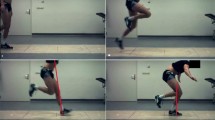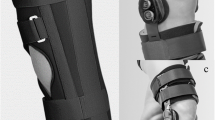Abstract
Purpose
The aims of the study were (1) to evaluate the leg asymmetry assessed with ground reaction forces (GRFs) during unilateral and bilateral movements of different knee loads in anterior cruciate ligament (ACL) reconstructed patients and (2) to investigate differences in leg asymmetry depending on the International Knee Documentation Committee Subjective Form (IKDC) in order to identify potential compensation strategies.
Methods
The knee function of 50 ACL reconstructed (patella tendon) patients was examined at 31 ± 7 months after the surgery. GRFs were quantified during the sit-to-stand and stand-to-sit test, the step-up and step-down test, and the two- and one-leg vertical jump. Further, the IKDC score, the anterior–posterior knee laxity, and the concentric torque of the quadriceps and hamstring muscles were evaluated.
Results
Differences between the operated and non-operated leg were found in the knee laxity, the quadriceps torque, and GRFs. The patients with low IKDC scores demonstrated greater leg asymmetries in GRFs compared to the patients with high IKDC scores.
Conclusions
ACL reconstructed patients showed GRF asymmetries during unilateral and bilateral movements of different knee loads. Three compensation strategies were found in patients with low subjective knee function: (1) a reduced eccentric load, (2) an inter-limb compensation during bilateral movements, and (3) the avoidance of high vertical impact forces. These compensation strategies may be indicative of a protective adaptation to avoid excessive ACL strain. GRF measurements are practicable and efficient tools to identify individual compensation strategies during early rehabilitation.

Similar content being viewed by others
References
Alentorn-Geli E, Myer GD, Silvers HJ et al (2009) Prevention of non-contact anterior cruciate ligament injuries in soccer players. Part 1: mechanisms of injury and underlying risk factors. Knee Surg Sports Traumatol Arthrosc 17(7):705–729
Anderson AF, Irrgang JJ, Kocher MS, Mann BJ, Harrast JJ (2006) The International Knee Documentation Committee Subjective Knee Evaluation Form: normative data. Am J Sports Med 34(1):128–135
Ardern CL, Taylor NF, Feller JA, Webster KE (2014) Fifty-five per cent return to competitive sport following anterior cruciate ligament reconstruction surgery: an updated systematic review and meta-analysis including aspects of physical functioning and contextual factors. Br J Sports Med. doi:10.1136/bjsports-2013-093398
Baumeister J, Reinecke K, Schubert M, Weiss M (2011) Altered electrocortical brain activity after ACL reconstruction during force control. J Orthop Res 29(9):1383–1389
Benjanuvatra N, Lay BS, Alderson JA, Blanksby BA (2013) Comparison of ground reaction force asymmetry in one- and two-legged countermovement jumps. J Strength Cond Res 27(10):2700–2707
Boden BP, Sheehan FT, Torg JS, Hewett TE (2010) Noncontact anterior cruciate ligament injuries: mechanisms and risk factors. J Am Acad Orthop Surg 18(9):520–527
Brosky JA Jr, Nitz AJ, Malone TR, Caborn DN, Rayens MK (1999) Intrarater reliability of selected clinical outcome measures following anterior cruciate ligament reconstruction. J Orthop Sports Phys Ther 29(1):39–48
Bryant AL, Kelly J, Hohmann E (2008) Neuromuscular adaptations and correlates of knee functionality following ACL reconstruction. J Orthop Res 26(1):126–135
Castanharo R, da Luz BS, Bitar AC, D’Elia CO, Castropil W, Duarte M (2011) Males still have limb asymmetries in multijoint movement tasks more than 2 years following anterior cruciate ligament reconstruction. J Orthop Sci 16(5):531–535
Chapman A, Chamberlain V, Railton R, Boyle J, Strauss G (1995) Extensor strength in the anterior cruciate reconstructed knee. Aust J Physiother 41(2):83–88
Chmielewski TL, Jones D, Day T, Tillman SM, Lentz TA, George SZ (2008) The association of pain and fear of movement/reinjury with function during anterior cruciate ligament reconstruction rehabilitation. J Orthop Sports Phys Ther 38(12):746–753
Collins NJ, Misra D, Felson DT, Crossley KM, Roos EM (2011) Measures of knee function: International Knee Documentation Committee (IKDC) Subjective Knee Evaluation Form, Knee Injury and Osteoarthritis Outcome Score (KOOS), Knee Injury and Osteoarthritis Outcome Score Physical Function Short Form (KOOS-PS),Knee Ou. Arthritis Care Res 63(S11):S208–S228
Dai B, Butler RJ, Garrett WE, Queen RM (2012) Anterior cruciate ligament reconstruction in adolescent patients: limb asymmetry and functional knee bracing. Am J Sports Med 40(12):2756–2763
Dai B, Butler RJ, Garrett WE, Queen RM (2014) Using ground reaction force to predict knee kinetic asymmetry following anterior cruciate ligament reconstruction. Scand J Med Sci Sports 24(6):974–981
Di Stasi SL, Logerstedt D, Gardinier ES, Snyder-Mackler L (2013) Gait patterns differ between ACL-reconstructed athletes who pass return-to-sport criteria and those who fail. Am J Sports Med 41(6):1310–1318
Ericsson YB, Roos EM, Frobell RB (2013) Lower extremity performance following ACL rehabilitation in the KANON-trial: impact of reconstruction and predictive value at 2 and 5 years. Br J Sports Med 47(15):980–985
Gardinier ES, Di Stasi S, Manal K, Buchanan TS, Snyder-Mackler L (2014) Knee contact force asymmetries in patients who failed return-to-sport readiness criteria 6 months after anterior cruciate ligament reconstruction. Am J Sports Med 42(12):2917–2925
Gokeler A, Hof AL, Arnold MP, Dijkstra PU, Postema K, Otten E (2010) Abnormal landing strategies after ACL reconstruction. Scand J Med Sci Sports 20(1):e12–e19
Gokeler A, Benjaminse A, van Eck CF, Webster KE, Schot L, Otten E (2013) Return of normal gait as an outcome measurement in acl reconstructed patients: a systematic review. Int J Sports Phys Ther 8(4):441–451
Harris JD, Abrams GD, Bach BR et al (2014) Return to sport after ACL reconstruction. Orthopedics 37(2):e103–e108
Heijne A, Fleming BC, Renstrom PA, Peura GD, Beynnon BD, Werner S (2004) Strain on the anterior cruciate ligament during closed kinetic chain exercises. Med Sci Sports Exerc 36(6):935–941
Impellizzeri FM, Bizzini M, Rampinini E, Cereda F, Maffiuletti NA (2008) Reliability of isokinetic strength imbalance ratios measured using the Cybex NORM dynamometer. Clin Physiol Funct Imaging 28(2):113–119
Jordan MJ, Aagaard P, Herzog W (2014) Lower limb asymmetry in mechanical muscle function: a comparison between ski racers with and without ACL reconstruction. Scand J Med Sci Sports. doi:10.1111/sms.12314
Kiapour AM, Murray MM (2014) Basic science of anterior cruciate ligament injury and repair. Bone Joint Res 3(2):20–31
Krosshaug T, Nakamae A, Boden BP et al (2007) Mechanisms of anterior cruciate ligament injury in basketball: video analysis of 39 cases. Am J Sports Med 35(3):359–367
Kvist J, Gillquist J (1999) Anterior tibial translation during eccentric, isokinetic quadriceps work in healthy subjects. Scand J Med Sci Sports 9(4):189–194
Laudani L, Giombini A, Mariani PP, Pigozzi F, Macaluso A (2014) Application of the sit-to-stand movement for the early assessment of functional deficits in patients who underwent anterior cruciate ligament reconstruction. Am J Phys Med Rehabil 93(3):189–199
Linthorne NP (2001) Analysis of standing vertical jumps using a force platform. Am J Phys 69(11):1198–1204
Logerstedt D, Di Stasi S, Grindem H et al (2014) Self-reported knee function can identify athletes who fail return to activity criteria up to 1 year after anterior cruciate ligament reconstruction: a Delaware-Oslo ACL Cohort Study. J Orthop Sports Phys Ther. doi:10.2519/jospt.2014.4852:1-27
Lysholm J, Gillquist J (1982) Evaluation of knee ligament surgery results with special emphasis on use of a scoring scale. Am J Sports Med 10(3):150–154
Moisala AS, Jarvela T, Kannus P, Jarvinen M (2007) Muscle strength evaluations after ACL reconstruction. Int J Sports Med 28(10):868–872
Oberländer KD, Brüggemann G-P, Höher J, Karamanidis K (2013) Altered landing mechanics in ACL-reconstructed patients. Med Sci Sports Exerc 45(3):506–513
Orishimo KF, Kremenic IJ, Mullaney MJ, McHugh MP, Nicholas SJ (2010) Adaptations in single-leg hop biomechanics following anterior cruciate ligament reconstruction. Knee Surg Sports Traumatol Arthrosc 18(11):1587–1593
Ortiz A, Olson S, Libby CL et al (2008) Landing mechanics between noninjured women and women with anterior cruciate ligament reconstruction during 2 jump tasks. Am J Sports Med 36(1):149–157
Pallant J (2010) SPSS survival manual: a step by step guide to data analysis using SPSS, 4th edn. McGraw Hill, Maidenhead, Berkshire
Paterno MV, Ford KR, Myer GD, Heyl R, Hewett TE (2007) Limb asymmetries in landing and jumping 2 years following anterior cruciate ligament reconstruction. Clin J Sport Med 17(4):258–262
Paterno MV, Schmitt LC, Ford KR et al (2010) Biomechanical measures during landing and postural stability predict second anterior cruciate ligament injury after anterior cruciate ligament reconstruction and return to sport. Am J Sports Med 38(10):1968–1978
Podraza JT, White SC (2010) Effect of knee flexion angle on ground reaction forces, knee moments and muscle co-contraction during an impact-like deceleration landing: implications for the non-contact mechanism of ACL injury. Knee 17(4):291–295
Pugh L, Mascarenhas R, Arneja S, Chin PY, Leith JM (2009) Current concepts in instrumented knee-laxity testing. Am J Sports Med 37(1):199–210
Roos PE, Button K, van Deursen RW (2014) Motor control strategies during double leg squat following anterior cruciate ligament rupture and reconstruction: an observational study. J Neuroeng Rehabil 11:1–19
Shelbourne KD, Klotz C (2006) What I have learned about the ACL: utilizing a progressive rehabilitation scheme to achieve total knee symmetry after anterior cruciate ligament reconstruction. J Orthop Sci 11(3):318–325
Tengman E, Brax Olofsson L, Nilsson KG, Tegner Y, Lundgren L, Hager CK (2014) Anterior cruciate ligament injury after more than 20 years: I. Physical activity level and knee function. Scand J Med Sci Sports 24(6):e491–e500
Thomee R, Kaplan Y, Kvist J et al (2011) Muscle strength and hop performance criteria prior to return to sports after ACL reconstruction. Knee Surg Sports Traumatol Arthrosc 19(11):1798–1805
van der Harst JJ, Gokeler A, Hof AL (2007) Leg kinematics and kinetics in landing from a single-leg hop for distance: a comparison between dominant and non-dominant leg. Clin Biomech 22(6):674–680
Webster KE, Austin DC, Feller JA, Clark RA, McClelland JA (2014) Symmetry of squatting and the effect of fatigue following anterior cruciate ligament reconstruction. Knee Surg Sports Traumatol Arthrosc. doi:10.1007/s00167-014-3121-3
White K, Logerstedt D, Snyder-Mackler L (2013) Gait asymmetries persist 1 year after anterior cruciate ligament reconstruction. Orthop J Sports Med 1(2):1–6
Yoon T, Hwang J (2000) Comparison of eccentric and concentric isokinetic exercise testing after anterior cruciate ligament reconstruction. Yonsei Med J 41(5):584–592
Acknowledgments
We thank K. Mießen for her help in data acquisition and the HELIOS Research Center for funding the study.
Conflict of interest
The authors declare that they have no competing interests. The study was funded by the HELIOS Research Center (ID 006745).
Author information
Authors and Affiliations
Corresponding author
Rights and permissions
About this article
Cite this article
Baumgart, C., Schubert, M., Hoppe, M.W. et al. Do ground reaction forces during unilateral and bilateral movements exhibit compensation strategies following ACL reconstruction?. Knee Surg Sports Traumatol Arthrosc 25, 1385–1394 (2017). https://doi.org/10.1007/s00167-015-3623-7
Received:
Accepted:
Published:
Issue Date:
DOI: https://doi.org/10.1007/s00167-015-3623-7




